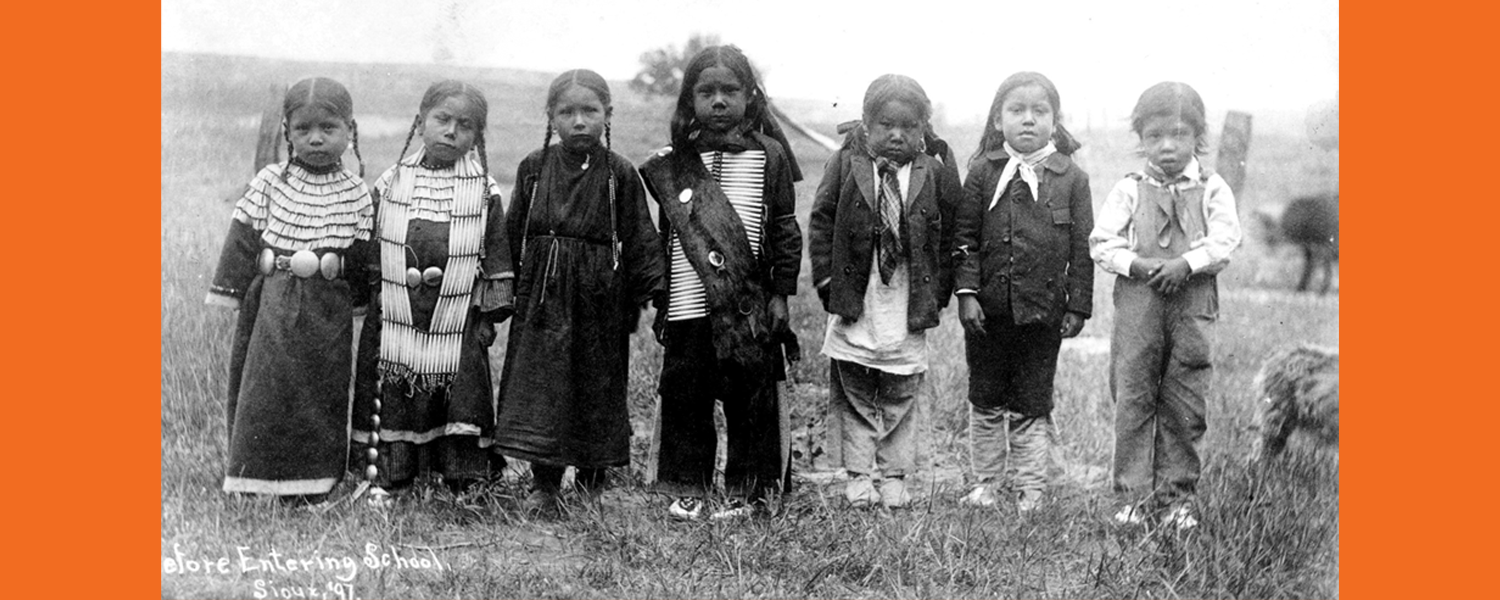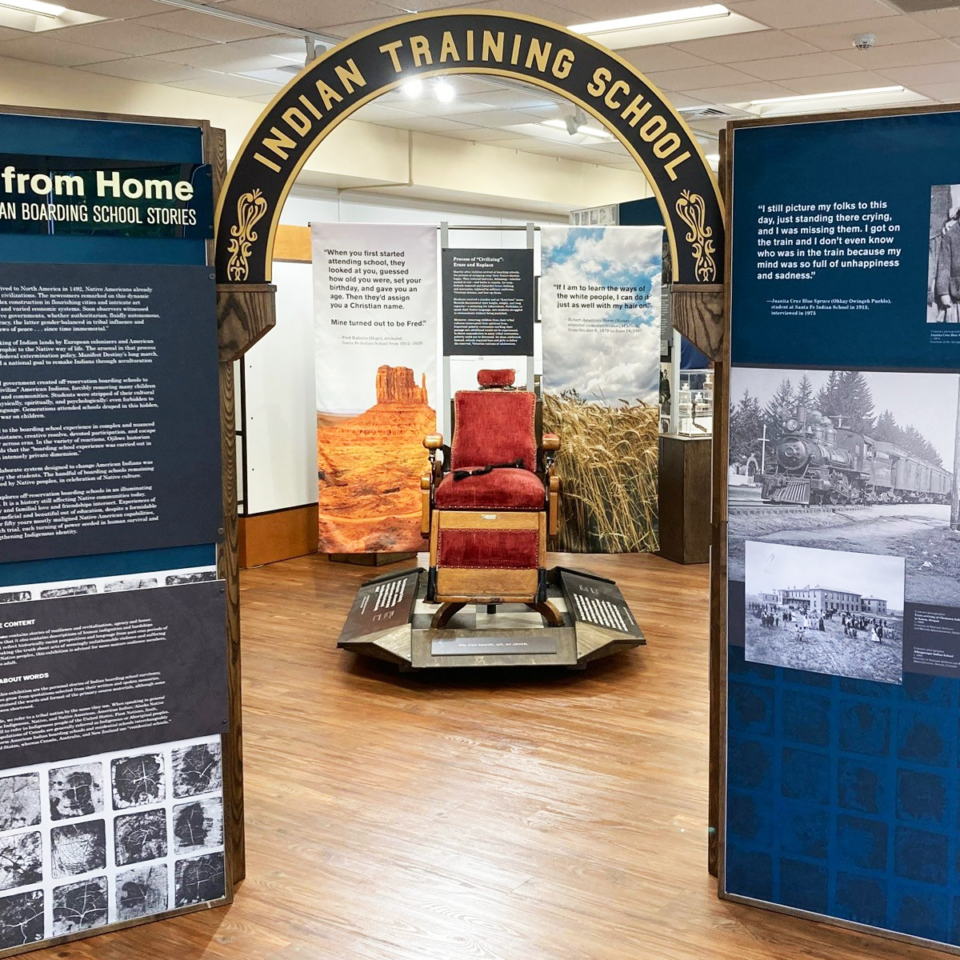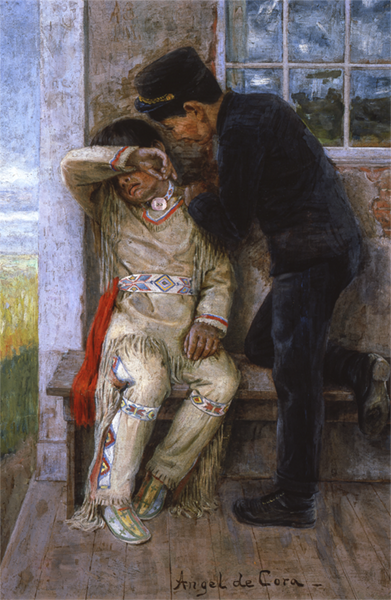Traveling exhibition confronts a thorny chapter of U.S. History
By Becky Brown

A vintage barber chair might seem like nothing more than a curiosity. But its luxurious red-velvet seat and headrest belie the experience many children had while seated in its lush confines.
Upon arrival at off-reservation boarding schools, Native American children were stripped of their Indigenous clothes, bathed in lye soap, and given “American” haircuts. Hours after their arrival, the children were paraded in military-style uniforms and Victorian dresses. They were forbidden to speak their Native tongues.
Some of these children had been forcibly removed from their families. Most had traveled hundreds of miles away from loved ones they might never see again. Some children were as young as five.

Away From Home installation image courtesy of Mountain Heritage Center, North Carolina
That vintage barber chair, which displays a cut braid lying on its plush seat, greets visitors to Away From Home: American Indian Boarding School Stories, a traveling exhibition from M-AAA’s ExhibitsUSA. The installation tells the stories of the 500,000 Native Americans who attended, many forcibly, Indian boarding schools. Started in the 1870s, the schools aimed to “civilize” Indigenous children, make them embrace Christianity, and prepare them for trade or domestic work.
It’s a difficult history, but a multifaceted one.
Away From Home explores the boarding school experience through first-person accounts, interactive elements, original artifacts, and works of art. But it’s not a one-sided tale of indignity. Instead, the exhibition respects the students’ experiences and recognizes the generational impact. It also explores how some students assimilated while others reinforced their cultural identities.
It’s this nuanced portrayal that makes Away From Home so powerful—and necessary. The exhibition was originally created in 2000 at the Heard Museum in Phoenix, Arizona. It was intended to be a temporary installation, but the story had a life of its own. Almost 20 years after the exhibition opened, the late National Endowment for the Humanities’ NEH on the Road program financed a traveling installation. However, when the NEH program ended, Away From Home was left without a home.
Thanks to generous donations, Mid-America Arts Alliance was able to step in. Along with support from the Chickasaw Nation, M-AAA’s ExhibitsUSA continued to offer the traveling exhibition at an affordable price to small- and mid-sized arts and cultural organizations in such cities as Red Wing, Minnesota; Cullowhee, North Carolina; and El Paso, Texas.

Angel DeCora, Untitled painting, ca. 1900; oil on canvas, 27 1/8 x 18 1/8; Courtesy Darling Family Collection.
Now, more people can explore the nuances of education and identity.
The Indian boarding schools were designed to remake Native Americans, but the Native Americans ultimately remade the schools. After graduation, many became involved in tribal political office, civil rights, or school-reform movements. The schools that survived changed substantially. Today, the federal Bureau of Indian Education runs four off-reservation boarding schools. But now, Native communities support the schools, which highlight the culture and history of Indigenous students.
“[Boarding schools] were started to stamp out the Indian from the Indian, you know, make us all into white people, and you know, it didn’t work,” says Ruthe Blalock Jones, a Delaware/Shawnee/Peoria artist from Oklahoma. “Actually … it was the exact opposite: It made us stronger as Indian People. It made us more aware of and more proud of who we were.”
____
Away From Home is one of the many traveling exhibitions from ExhibitsUSA available for booking. The exhibition is accompanied by educational and programming resources, including a 160-page guide.
Because of generous support from funders like the National Endowment for the Arts and many private and individual donors, ExhibitsUSA is able to provide exhibitions like this to small and mid-sized arts and cultural organizations at a fraction of the cost. While the shipping costs alone could put this exhibition out of reach for many institutions, ExhibitsUSA was able to make Away from Home available for just $3,000 for in-region bookings, including shipping.

